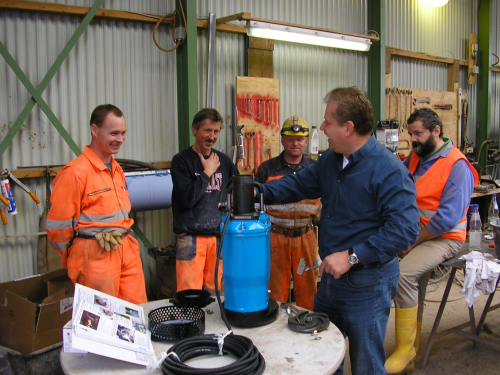
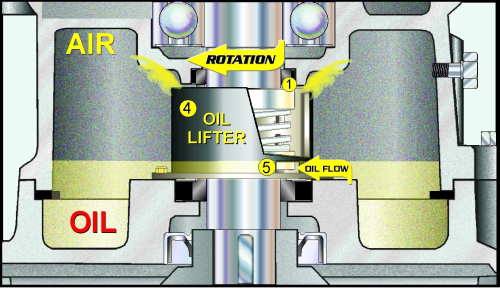
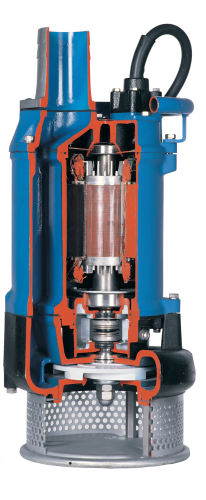
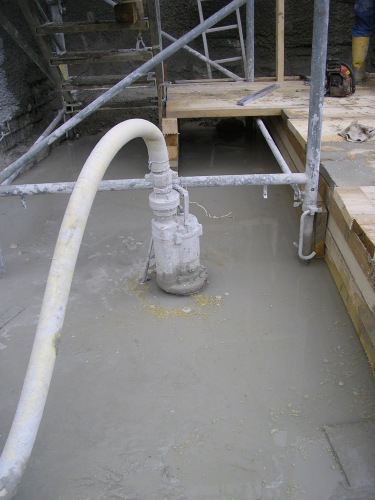
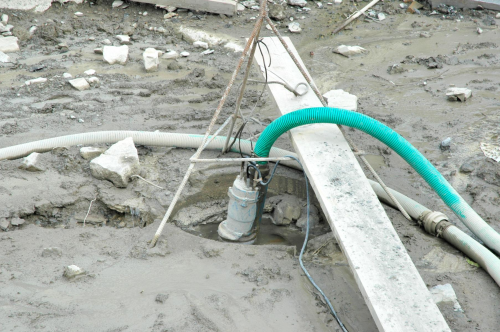
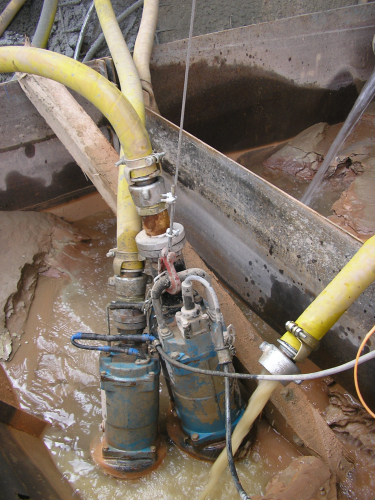
Whether you are pumping clear or dirty water, if the temperature drops below 0°C it is important to take precautions. The first thing that operators need to be aware of is that it is vitally important to clear the pump of fluid when not in use. If this is overlooked there is a danger of leakage, cracking or even complete bursting of the pump casing.
When frozen, standing water in the pump can increase in volume by up to 9%. In a worst-case scenario that can be enough to crack open the pump casing, which is usually made of cast iron or aluminium. Pump manufacturers are unable to design against this breakage — even pump casings made from stronger materials would suffer the same fate against the sheer strength of frozen water. Although this is one of the easiest problems to guard against, failure to do so can lead to some costly repair bills, not to mention unfortunate project delays.
Key considerations
Keeping an eye on the water temperature is, of course, vital to the smooth running of pumps in colder climates but there are other considerations to bear in mind. Pumping below-average temperature media does not normally cause problems on its own but operators should make concessions for the fact that their pumps will operate with a lower pumping capacity because media at lower temperatures pump at a decreased flow rate.
When water is pumped in frosty weather, the surface water is cooler than water at greater depths. This is important when working in deep wells or with groundwater that has accumulated in a sump pit because it can pose a hidden risk. At the beginning of a pump operation the pump is submerged deep in warmer water areas. After the pump has been running for a period of time, the water level will drop and the colder water from the surface will enter the pump. At this point there is a danger that the pump might freeze, which may not have been apparent at the beginning of the operation, when the water temperature was higher.
The danger of pumping in freezing conditions can be as bad, if not worse, when working on above-ground construction projects. For these types of projects, it is likely that the pump will often work in ‘interval’ mode or in suction mode. Under these circumstances, when there is only a small amount of water being pumped (or the pump is running dry occasionally) there is a significant danger of the pump freezing tightly.
One further consideration that operators should be aware of when working in cold environments is that different media have different consistencies and therefore different freezing points. This should be taken into account when planning which pumps to use (Figure 1) and how often to check equipment.
Don't forget the oil
Besides the medium being pumped there is another liquid vital to the smooth running of pumps in freezing conditions and that is the lubricant oil, without which no pump can operate. The viscosity of lubricant oil increases at lower temperatures, which in turn raises the issue of possible pump malfunction due to insufficient lubrication.
What many operators fail to realize is that, even if the weather conditions are arctic, a pump can still run hot and will most likely ruin itself if it does so. Tsurumi pumps offer effective protection and peace of mind against this kind of permanent damage thanks to an innovative design feature. All pumps in the Tsurumi range come equipped with a patented oil lifter (Figure 2) that supplies the mechanical seal with enough lubricant at all times. The oil lifter is a special device attached to the pump shaft. When the pump is in operation it picks up the oil from the bottom of the shaft and raises it to the top, thus coating the entire pump shaft and keeping the rotating parts moving.
Choose your equipment carefully
If you are hoping to minimize pump damage when working in cold climates then it is crucial to opt for a pump that is manufactured from suitable materials (Figure 3). For example, contractor pumps (Figure 4) are ideal if ditches need to be emptied because they are designed for the toughest jobs and are generally more robust. It is highly recommended that a pump be chosen with an agitator at the entrance of the suction opening — an agitator mixes sludge and sediment in the medium to make it more fluent, meaning less risk of abrasion damage. It is also important to observe manufacturers' guidelines regarding how thick the pumped medium can be since most wear is usually caused by abrasion.
As the sediment in the water flows through the pump, it will attack even the hardest materials at some point. Contractor pumps undergo a great deal of stress, so the demands placed on the materials are high. Chromium cast iron or cast iron with spheroidal graphite should be chosen for heavy-use parts such as impellers. For the pump housing, grey cast iron is ideal — it is not only more abrasion-resistant than aluminium, but also more resistant to corrosion. Furthermore, it can be used across a wide range of pH-levels, which is important for contaminated liquids (aluminium should only be chosen if weight is a factor). For the most critical part — the mechanical seal — silicon carbide is the only choice. With an almost diamond-like hardness, this material is heat-resistant up to 2000°C, unlike tungsten carbide or other hard metals.
Operators should also pay attention to the chemical properties of the medium to be pumped when thinking of making a purchase: for corrosive fluids the internal parts should be made of austenitic steel; where seawater is the liquid in question then titanium is the most appropriate metal. The specification does not always need to be high-tech: quite often cast iron is ideal. The material is not only wear-resistant and not susceptible to abrasion, but also quite resistant against corrosion and suitable for a large range of pH-levels.
Avoiding operator errors
In a frosty environment, it isn't pleasant to have to venture out every couple of hours to check whether a pump is still working. And having to undertake repairs in sub-zero temperatures is less pleasant still. Happily, there are some simple tips that operators can use to keep their pumps in optimal working order. Here is a ‘top ten’ list of the most common operational errors to avoid — equally applicable in summer, they become doubly important in the winter months.
1. Do not use the cables to lift the pump
Even if you are in a rush, pumps should only be lifted by the handle or with a rope or chain (Figure 5), not by the cable. Otherwise the cable will tear, or the insulation will suffer, and water could enter the motor.
2. Avoid sharp bends in the hose
Sharp bends or compression of the hose reduces the flow speed of the medium. Consequently, sediment can settle in the hose, reducing the flow even further. Form-stable hoses are ideal, especially for the first few metres.
3. Observe correct rotation
Especially on construction sites, cables can easily be connected the wrong way round and phases can become mixed up. If movement to the left can be felt, the rotation direction is correct and the pump will operate at full power.
4. Measure generator power properly
If the pump is powered by a generator, then calculating generator size is important in order to supply enough power to the pump.
5. Install a pump sump
To avoid sediment unnecessarily wearing the rotating parts, installing a sump pit is recommended (Figure 6). This may be achieved with a basket, or by placing the pump in a gravel bed.
6. Protect the power cable
Avoid damage caused by sharp edges. Ensure the cable is never rolled over by heavy trucks.
7. Unplug the pump before attempting maintenance
Never carry out maintenance to the pump if it is still connected to the power supply. Cable repairs should be undertaken by qualified staff only.
8. Use correct extension cables
Adhere to correct cable sizes. The longer the cable, the larger the diameter of the cable must be, if you want to avoid a loss of power. Longer cables should not be rolled up.
9. Avoid submersion in mud or clay
To achieve optimal performance, the pump should be placed in a bed of large gravel, or on two planks, or it should be suspended. Alternatively, it can also be placed inside a perforated oil drum. This prevents larger-grained sediment from reaching the pump, and at the same time prevents the pump from digging itself into the ground.
And finally…
10. Do not exceed maximum delivery head
The pump should always be operated within proper parameters. The specific weight of the medium, the atmospheric pressure and friction losses can all influence pump performance and should be checked for every new project.
So, with careful site preparation, one eye on the weather and another on the pumping conditions, the majority of mistakes can be avoided. In the coldest operating conditions, however, the greatest contribution operating companies can make to the successful completion of their project, with minimal downtime and lower repair bills, is to choose appropriate equipment from a reliable manufacturer.





